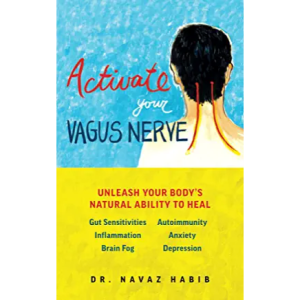What Happens in Vagus Stays in Vagus? Yep, But it Wanders Around Too!
 That is if we’re referring to the vagus nerve. The word vagus is Latin for travel or wander. You might be familiar with this Latin root, knowing the word vague, which is an idea that meanders around, or from the word vagabond which is a person who wanders. The vagus nerve travels from the brainstem to the intestines. The longest nerve, it is the 10th cranial nerve connecting and innervating many organs on its way down the body – including the heart, lungs, and digestive system. For our purposes, the most important thing that it does is when the diaphragm contracts during inhalation, it stimulates the vagus nerve which activates the parasympathetic nervous system of “rest and digest.” Upon inhalation, the lungs push down the diaphragm, creating pressure for air to be expelled. This stimulates the vagus nerve leading to a decrease in heartbeat, blood pressure, etc. Practicing things that can tone and activate the vagus nerve can enhance our overall well-being as we “come down our ‘ometers” toward homeostasis and calm. (CLICK HERE for The Breathing Contest™)
That is if we’re referring to the vagus nerve. The word vagus is Latin for travel or wander. You might be familiar with this Latin root, knowing the word vague, which is an idea that meanders around, or from the word vagabond which is a person who wanders. The vagus nerve travels from the brainstem to the intestines. The longest nerve, it is the 10th cranial nerve connecting and innervating many organs on its way down the body – including the heart, lungs, and digestive system. For our purposes, the most important thing that it does is when the diaphragm contracts during inhalation, it stimulates the vagus nerve which activates the parasympathetic nervous system of “rest and digest.” Upon inhalation, the lungs push down the diaphragm, creating pressure for air to be expelled. This stimulates the vagus nerve leading to a decrease in heartbeat, blood pressure, etc. Practicing things that can tone and activate the vagus nerve can enhance our overall well-being as we “come down our ‘ometers” toward homeostasis and calm. (CLICK HERE for The Breathing Contest™)
The book, Activating the Vagus Nerve by Navaz Habib is a wonderful resource for hacking the vagus nerve. (CLICK HERE to see it on Amazon) I have had the opportunity to meet Dr. Habib and learn from his wisdom. After reading his book and meeting him, I have regularly utilized many of his vagus nerve suggestions for my own daily health regimen. Dr. Habib recommends some easy activities to tone your Vagus Nerve for resilience and recovery. Regularly practicing activities to stimulate the vagus nerve enhances our overall wellbeing. In his book (link above), Dr. Habib’s book has charts that break the activities down into daily, weekly, and monthly activities. Here are a few of his suggestions:
Daily: Gargling (2x/day), humming (2x/day), deep breathing (3x/day), cold-contrast shower* (1x/day)
Weekly: Light exercise with conscious breathing (2x/week), social interaction (1-2x/week), meditation (3-7x/week)
Monthly: Check on your supplements (1x/month), massage or visceral manipulation (2x/month), Acupuncture (1-2x/month)
*Cold-contrast shower – this works on the principle of Hormesis (CLICK HERE to see my artice ablut this). If you have had an mRNA injection, please ask your healthcare provider if this activity is okay for you.
Other things you can do to stimulate the vagus nerve:
- Deep slow breathing (CLICK HERE for The Breathing Contest™)
- Singing, chanting, or humming
- Exposure to cold water or ice packs can activate the vagus nerve and promote relaxation.
- Various forms of massage and lymphatic drainage
- Laugh!
- Moderate exercise, such as walking or cycling.
- Certain strains of probiotics have been shown to increase vagal activity and improve mood.
- Spending time with loved ones and engaging in social activities
- Getting enough restful sleep
- Consuming foods rich in omega-3 fatty acids, such as salmon and flaxseeds,
- Simple, gentle neck massage of the neck can stimulate the vagus nerve, which runs through this area.
CLICK HERE for my FREE NOGA® Sound Solutions™ App for meditation and breathing exercises for toning your vagus nerve. It will help you make sure what happens in vagus, happens all around as well!
We love hearing from you, please feel free to leave your comments below.
With Gratitude,
Rus Devorah


